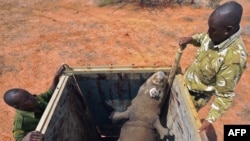Last May, a female black rhino named Naitamany was moved from Lewa Wildlife Conservancy to the Sera Community Rhino Sanctuary as part of a project to reintroduce black rhinos to the Samburu region of Kenya, once a rhino stronghold.
She was about five months pregnant at the time.
This month, the mama rhino gave birth to a healthy calf, making it the first black rhino in more than 25 years to be born on community land in northern Kenya.
Conservationists are pleased with this glimmer of hope, given that a surge in poaching has resulted in black rhinos being listed as critically endangered, with only about 5,000 left in the world.
"It shows the potential of Sera as a conservancy, to not only host black rhino of breeding population, but also their capability in managing such a population," said Antony Wandera, senior research and monitoring officer for the Northern Rangelands Trust, an umbrella organization for community conservancies across northern and coastal Kenya, including the Sera sanctuary.
Wandera says that the tribes living around Samburu have a special affinity for their wildlife — including rhinos, elephants and even wild dogs — making them uniquely qualified to look after the creatures.
"And nobody will want to harm these animals,” he said, “and when it comes now to putting the little resources that they have, they'll be happy and satisfied as members within those communities, seeing wildlife within their area, [rather] than letting somebody from a different area come and manage them."
Cost, benefits
But having the necessary resources is key. Protecting rhinos is an expensive operation these days, with donor money covering a majority of the costs of the Northern Rangelands Trust.
Ol Pejeta, for example, is the largest black rhino sanctuary in east Africa and home to the world's last remaining three northern white rhinos. It estimates the cost of protecting a rhino to be between $10,000 and $15,000 per year.
But the benefits have gone beyond wildlife.
Wandera says that Sera used to see conflicts when the Samburu, Rendille and Borana communities brought their livestock there, as the area was known as a dry season refuge. But through talks, the groups have learned to work together.
"This has really worked out very, very, very well,” he said, “because the three communities have not allowed any sort of poaching incidents to happen within that area for the whole of 2015."
The first rhinos were moved to Sera in 2015. The baby rhino's birth brings the sanctuary's population to 11, and officials expect to bring 10 more to Sera this year from other locations in Kenya.












